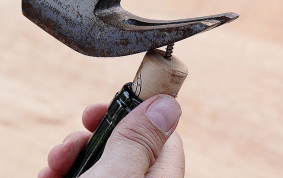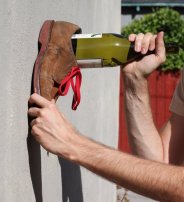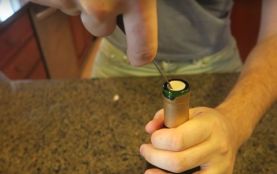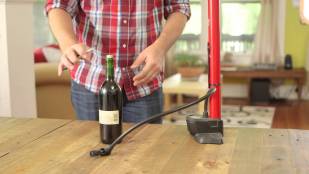Ah, time for a nice glass of Cabernet Sauvignon to accompany that fine cut of steak, ey?
Or perhaps you’re keen to serve you and that someone special a splash of Pinot Grigio to cool things down on a warm spring afternoon?
Or perhaps you’re breaking out a bottle of fine Merlot because Sideways novelist Alexander Payne be damned, you like Merlot, and you’re allowed to, because America.
Well, whatever wine you choose, you’re shit out of luck if you don’t have a corkscrew, to use the lexicon of the refined sommelier. That is, you’re SOL without a little bit of Macgyver-style ingenuity. Or, as another option, just read this article I took the time to write. If you can follow a few basic instructions, then you, sir, might still enjoy a glass of ’69 Livent Noir Chablis before the day is out! (Of course… that’s a totally fictional wine I just made up, so I’ll be confused if you manage that specific achievement. Perhaps try some Crane Lake?)
Related: Delicious Rainy Day Beers
So… how do you open a wine bottle without a corkscrew? If you only remember one thing from today, remember this: you do it carefully.
Oh, and remove the foil.

Almost every home is filled with random screws. Take a second to look around, and you’ll find one that’s perfect as a stand in for a corkscrew. You ideally want to find a slender screw that has wide, flat spirals. (For the record, this is to say a wood screw, as opposed to one meant for metals.) Next find a screwdriver. Now screw the screw down into the cork, making sure to leave enough sicking out that you can grasp it with a hammer’s claw or with a pair of pliers. I’ll let you reckon through the rest.

So you have no way to get that cork out of the bottle? Well, then perhaps we need to turn the tables on fate, and push the cork INTO the bottle! (And yes, I meant the Royal We, but if I’m invited, I’ll have a glass, sure.) The best tool for pushing a cork down into a wine bottle is one that’s not so hard it will break the cork into little pieces. I suggest the handle of a wooden spoon or, ideally, a dowel. Just line any slender, sturdy, cylindrical object up atop the cork and begin to tap away using a hammer or your very own hand (cup one over the dowel/spoon/etc. and tap with t’other). It will take some time, but it will work!

You can use physics to land on the moon, or you can use physics to open a bottle of wine. Yep. Anyway, many bottles of wine can be opened simply via internal pressure created by force. Try slipping the butt end of a wine bottle into your shoe then firmly bonking the heel of your shoe against a strong wall, a pole, and so forth. Alternatively, you can try just slapping the bottom of a wine bottle held horizontally with the ground. The wine sloshing back and forth should start to pop the cork out with enough bonks or slaps.

Now be careful, kids: you don’t want to accidentally knife yourself. Just ask ol Knifehand Tony about that one… poor guy. Anyway, this method can work with a slender, strong knife blade, with a scissor blade, or even with car keys, though it may be hard to get those in far enough for efficacy. You simply stab your implement down into the cork at a 45 degree angle, then slowly and steadily force the cork to twist around and around. Due to the pressure inside the bottle, as the cork loosens and rotates, it will almost always start to rise up and out as well.

Just to be on the safe side, maybe put on a pair of glasses before you try this one, OK? If you don’t have a corkscrew but you do have a pump, you may still be able to have a bottle of wine. (And go for a bike ride or play a game of volleyball! Hooray!) It’s simple, really: you just need to create enough pressure inside the wine bottle that the cork gives up the fight. Slide the pump’s needle down through the cork (a nail may be needed to open the channel) and then slowly and steadily pump away. Note that you might want to try drawing the pump’s needle out now and then, as the cork may rise with it.
Method #6: Smash the Bottle and Suck the Spilled Wine Off the Bathroom Floor While Weeping to Your Old Enya CD




